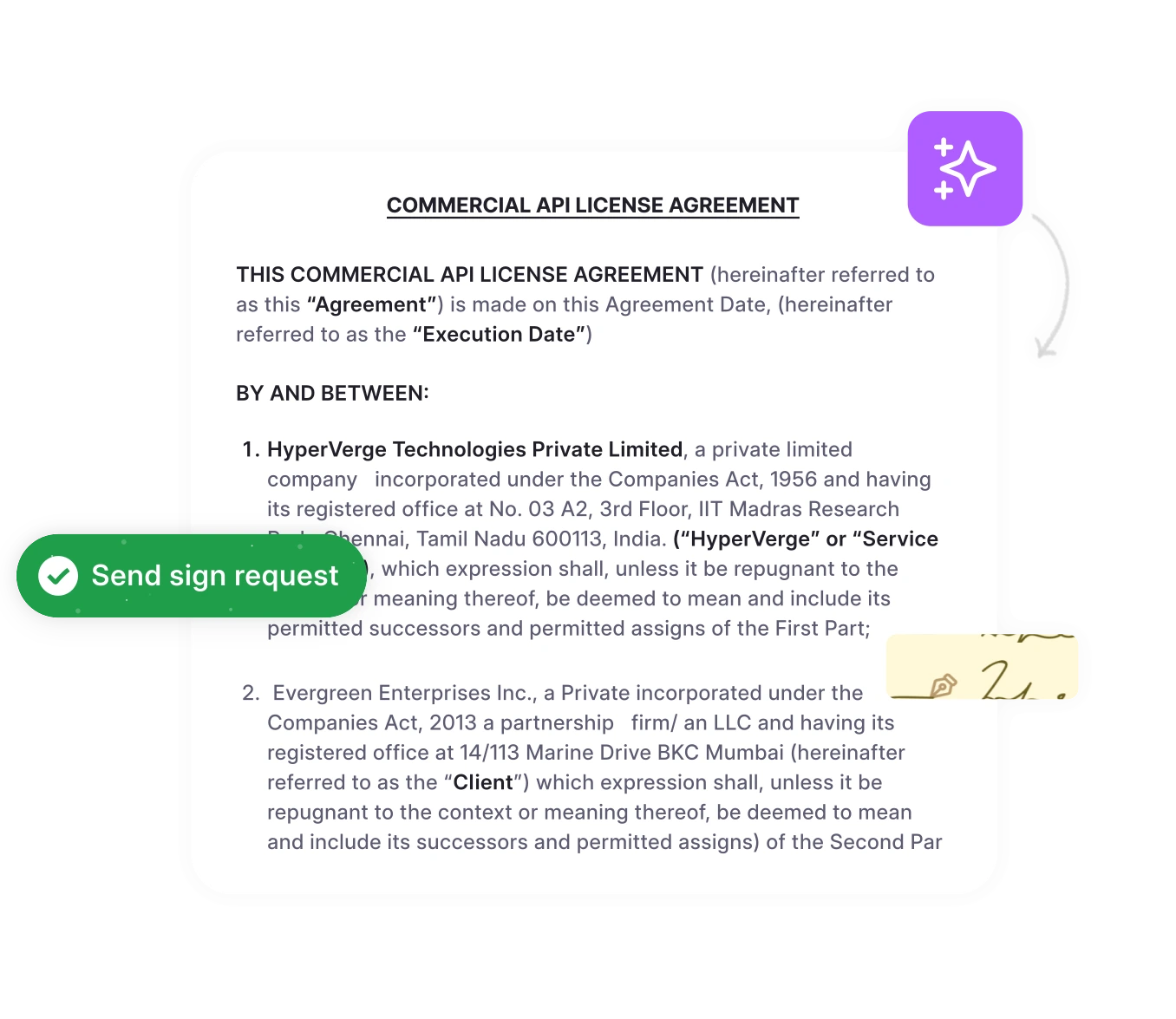Every strong business relationship begins with one thing: a well-drafted contract. While contract drafting is just the first stage of the contract lifecycle, it lays the groundwork for everything that follows. A good contract sets expectations, protects all parties, and builds trust from day one.
In this guide, you’ll learn how to draft contracts that are not only legally sound but also practical and easy to work with. We’ll cover:
- Key elements of good contracts
- How to structure and draft contracts well
- Common mistakes to avoid
- How HyperStart CLM helps draft contracts that people want to sign
This blog is for every legal professional who’d like to exchange traditional drafting practices for simpler and more useful ones.
What is contract drafting?
Contract drafting is the process of creating legal agreements in the form of written documents that outline the terms, conditions, rights, and obligations agreed upon by the parties involved in an agreement. This involves translating the intentions and understandings of those parties into clear and precise contract language so the contracts go from creation to completion with the least resistance.
In practice, effective contract drafting means:
- Identifying key obligations and deliverables
- Stratifying risks and planning for them
- Writing in language that non-legal folks can understand and review
While operationally strong contracts include detailed business terms, every legally enforceable contract must still meet legal formation standards:
- Offer (a clear proposal)
- Acceptance (unambiguous agreement)
- Consideration (something of value exchanged)
- Mutual consent (all parties agreeing willingly)
Getting these basics right, along with clear language and structure, is the foundation of drafting contracts that protect your business.
Now that we’ve covered the basics of contract drafting, let’s break down the must-haves that make a contract clear, enforceable, and aligned with business goals.
Key elements every well-drafted contract must include
Defining the contract terms is crucial while drafting. This includes outlining the rights and obligations of each party, payment terms, timelines, and deliverables to ensure clarity, accuracy, and resonance.
Whether you’re handling employment agreements, service contracts, or vendor deals, here are the core elements that should be included.
1. Identifying the parties involved
The contract must accurately state the full legal names and addresses of all individuals or entities agreeing. For businesses, include their legal structure (e.g., LLC, Inc., Partnership) and the state or country of incorporation. Precise identification of parties establishes legal standing. It defines who holds the rights and obligations under the contract.
2. Purpose and scope of the agreement
The scope of the agreement outlines what the contract is about and what each party is agreeing to do, the nature of the agreement, its objectives, deliverables, timelines, and any limitations to the work involved. The scope acts as the guiding framework for all other clauses and prevents scope creep.
A vague scope invites disputes over “what was promised.” Make sure you have a checklist of the expected scope of work before they are signed, so nothing is missed.
3. Payment terms and conditions
Detail all financial aspects of the agreement, outlining how, when, and under what conditions payments will be made. Payment terms aligned with business goals protect cash flow, reduce missed payments, and prevent billing disputes.
4. Confidentiality and intellectual property (IP) rights
When sensitive information or original work is involved, include confidentiality clauses (NDAs) and IP provisions. These protect trade secrets, proprietary data, and ownership of deliverables.
5. Termination rights and exit clauses
Every contract should define how it can be terminated, voluntarily or due to breach, and what happens after. Include notice periods, refund policies, and post-termination obligations.
6. Governing law and jurisdiction
The governing law and jurisdiction clause identify which region’s laws govern the contract and where legal disputes will be resolved. It’s especially important in international or interstate contracts.
7. Signature blocks
A contract must be signed to become legally binding. Include the names, designations, and authorized representatives for each party. Electronic contract signatures are increasingly acceptable under most jurisdictions.
Answering the same questions every day?
Automate self-serve contracts with precedent templates and clauses so you save time and close deals faster.
Book a DemoStep-by-step process to draft contracts
The steps below provide a reliable path to a well-structured and well-designed contract.
Step 1: Define the purpose and scope of the agreement
Before you type a single word, get clear on the intent behind the contract. What is the business relationship or transaction being documented? What are the outcomes each party expects? The purpose and scope set the foundation for everything that follows.
A vague or incomplete scope leads to long-winding reviews, misaligned expectations, and underperformance.
Step 2: Identify all parties and their legal obligations
Name the parties involved using their full legal names, registered business designations, and addresses. Specify their roles (e.g., service provider vs client), responsibilities, and any agents or third parties acting on their behalf.
Contracts are legally binding only when the parties are identifiable and are authorized to sign off on them.
Step 3: Draft key terms using clear, unambiguous language
This is the core of contract creation. Define all obligations, timelines, pricing structures, deliverables, payment schedules, and performance expectations. Use concise and plain language that leaves no room for misinterpretation.
Overly complex or vague language creates loopholes, delays enforcement, and increases legal risk.
Example — Instead of:
“The first party shall render services upon commencement of the arrangement.”
Say:
“The Consultant will begin services on May 1, 2025, and deliver the project report by July 15, 2025.”
And since there are no Pulitzers (not yet, anyway!) for the most perfectly worded long-form contract, I will keep my business partners engaged and happy by drafting shorter business stories, whenever possible, utilizing clear, concise language.
– Angela Lawrie, Senior Counsel at RxBenefits
Step 4: Structure the agreement with logical flow and formatting
Organize the content so that it’s easy to navigate and digest. Use headings, subheadings, numbering, and spacing to guide the reader. Typical flow:
- Introduction
- Scope of work
- Payment terms
- Confidentiality/IP
- Liability and indemnity
- Termination and dispute resolution
- Signature blocks
For long contracts, add a table of contents and separate appendices or exhibits.
Step 5: Include essential legal and business-specific clauses
Don’t rely only on templates. Tailor your contract with clauses relevant to the specific business context. Examples:
- Confidentiality — to protect trade secrets
- Force majeure — to address unexpected disruptions
- IP ownership — especially for creative or software deliverables
- Data protection — if personal or customer data is involved
- Indemnity and liability limits — to manage risk exposure
- Termination rights — to define how the contract ends
Every business and industry faces different risks. Standardized contracts that skip key clauses can leave major gaps.
Maintain a clause library. You don’t always have to reinvent the wheel.
Step 6: Review, redline, and collaborate with stakeholders
Once the first draft is ready, circulate it to the right internal and external stakeholders — legal, finance, business leads, or third-party counsel. You can use a collaborative contract redlining tool to make edits, track changes, and add comments centrally.
Building relationships with stakeholders and counterparties is an imperative not taught at university. Multiple perspectives help catch blind spots, strengthen legal language, and align the contract with business goals.
Parallel review. If I am helping a colleague with their redline, I’ll do a quick parallel review of the agreement before talking through their redline with them to ensure nothing important has been missed.
Michael Astle, VP Legal Affairs at Quotient Sciences
Step 7: Finalize, approve, and store the contract securely
Once all revisions are complete and both parties are aligned, prepare the final version. Collect signatures digitally or physically and record the execution date. Then, store the contract in a secure, searchable location with user-based access controls.
Best practices for smarter and scalable contract drafting
Even the most experienced, sharp lawyers are far better at negotiations and analytical work than at contract generation and editing. Typically, lawyers learn how to author contracts from mentors who hired them after school. Their style then evolves without a critical examination of traditional jargon. This perpetuates poor drafting habits from one generation of lawyers to the next. Here are some best practices today to elevate your contract drafting process:
1. Use pre-approved templates to reduce errors and speed up drafting
Pre-approved contract templates are your first line of defense against errors and inconsistencies. By standardizing core contract structures and clauses, you create a contract foundation that ensures compliance with both internal and external legal requirements.
Templates with pre-approved legal guidelines can be practical and useful resources to save time, maintain contract uniformity, and eliminate human error. But before picking a template, make sure your purpose is clear.
Is it to protect your client? Achieve a certain risk allocation? Capture agreed terms? Place particular obligations on the other party? Usually, it’s all of these combined.
As for what you shouldn’t do…
Don’t just pull a template or precedent contract off the shelf and use it without having read and understood the contract and answered these questions.
Rachelle Hare, Director at Blaze Business & Legal
2. Standardize clause libraries for consistency and compliance
Maintain a structured, up-to-date repository of:
- Payment terms
- IP ownership clauses
- Indemnity and limitation of liability language
- Termination provisions
This makes contracts easier to draft and review, and ensures risk protections are consistently applied.
3. Collaborate in real-time with internal and external stakeholders
Deputy General Counsel at Airbus OneWeb Satellites
Involving the right stakeholders early in the drafting process ensures complete stakeholder alignment, making sure that all perspectives — legal, business, and technical — are accounted for and contracts go out the door faster. Use contract collaboration tools that allow all parties to edit, comment, and track changes in real-time.
Sarah Irwin Learn the business you represent. Some ways to do this:
- Get technical folks to walk you through the product.
- Join sales calls and review battle cards to know the USP.
- Keep the org chart handy so you know who’s involved and how they add value.
- Get the genesis and rationale for everything from the co-founders, like product, first hires, and so on.
- Align legal team goals directly with the company’s goals and values.
4. Leverage contract management tools to automate version tracking and approvals
Contract management software is indispensable for modern businesses looking to scale their contract processes. These tools help automate version tracking, approval workflows, and even fallback clauses.
These tools improve accuracy and efficiency by automating routine tasks. They also provide full visibility into the contract approval process and maintain an audit trail, ensuring that all changes are documented and can be reviewed at any time.
5. Stay abreast of your niche, market norms, and jurisdictions
Contracts were not meant to be static legal documents. They evolve as your business grows and the legal landscape changes. So, dive into the meaty clauses like privacy and indemnification when legislative bills are on the table.
Continuous improvement ensures your contracts remain up-to-date, compliant, and reflective of current business practices.
- Establish the purpose.
- Start with an outline.
- Aim for simplicity, brevity, and resonance.
- Front-load key terms like pricing, IP, and exit so they are not buried deep.
- Gather relevant inputs from stakeholders like peers, sales, and finance.
Common drafting mistakes that cost time, money, and your precious mindspace
Here are the most common pitfalls and how to avoid them:
1. Using vague or complex language
It’s easy to slip into using jargon that nobody but the legal team understands. But this can lead to email ping-pongs and markup-heavy reviews. Ambiguous and complex terms are one of the top reasons for contract disputes. When parties don’t fully understand the agreement, it opens the door to misinterpretation.
2. Rushing past key clauses
Skipping quickly through critical clauses like confidentiality, IP ownership, indemnity, or dispute resolution can be risky. Imagine that you’ve drafted a comprehensive contract protecting your company’s interest, but you missed a word or two. This can put you at risk, delay approvals, and jeopardize contract cycle times. Make sure every review is carefully done to protect the company’s interest.
3. Failing to tailor templates to the business
Templates are valuable for efficiency, but make sure you get them right. Understanding customer margins, how your company makes money, and who your competitors are can point you to the right contracts to automate.
Krista Russel, Deputy General Counsel at Airbus OneWeb Satellites, recommends surveying the top contracts that make you money and the ones that cost you money before you work through the boilerplate. That way, you have an opportunity to add strategic value while you automate standard form contracts.
4. Relying only on manual reviews without documentation or version control
Without automated version control, it’s easy to lose track of edits, overlook stakeholder input, or end up using the wrong contract version during negotiations. Make sure you document transparently and thoroughly without relying on memory to establish context.
5. Reviewing contracts independently
Reviewing contracts before signing can benefit from a different approach to etiquette. Going back and forth on clauses may not be very useful anymore.
Instead, take the time to have a legal-to-legal conversation to candidly discuss the other’s stance and find middle ground. You can also color-code and comment sections that you markup to explain your rationale instead of plain redlines.
Some of the best CLM platforms are designed to help nurture excellent contract drafting practices. You need a CLM partner that is deeply aligned with your values and goals.
Contract drafting for a faster yes
Empower your business with self-serve contract creation processes. No more answering the same questions repeatedly.
Book a DemoHow modern CLM platforms simplify and improve contract drafting
1. AI-powered drafting assistance
Modern contract creation software like HyperStart CLM leverages artificial intelligence to help legal and business teams create higher-quality contracts, faster:
- AI-assisted clause suggestions based on contract type, industry, and historical preferences.
- Deviation detection from approved templates and fallback clauses.
- Automated compliance checks that flag risky or non-standard language.
2. Real-time collaboration and built-in version control
With modern CLM platforms, collaboration moves from email to an intuitive, shared workspace:
- Simultaneous editing and commenting allow teams to resolve issues faster.
- Automated version tracking keeps a complete audit trail of all changes.
- Stakeholder tagging, task assignment, and comment threads promote accountability.
3. Automated workflows and approval routing
CLM systems bring order and efficiency to contract approval processes that were previously ad hoc:
- Sequential and parallel routing based on business rules.
- Automatic reminders to prevent approval bottlenecks.
- Playbook-driven fallback logic to standardize negotiations.
- Dashboard tracking of contract status across departments.
4. Self-service drafting for business users
One of the most transformative benefits of modern CLM platforms is the ability to empower non-legal users to create low-risk contracts on their own. With pre-approved templates and smart form-based inputs, business teams can generate:
- Sales: NDAs, MSAs, and standard form of business contracts
- Human Resources: Employment offers and onboarding legal documents
- Procurement Team: Vendor agreements and supplier contracts
5. Seamless integration with enterprise tools
CLMs integrate with your existing tech stack to automate data population and trigger contract actions:
- Connect CLM directly with leading CRM platforms such as Salesforce, HubSpot, and Pipedrive.
- Integrate document management solutions like Google Drive, OneDrive, and SharePoint with CLM for secure, centralized storage and collaboration.
- Integrate DocuSign, Adobe Acrobat Sign, and Zoho Sign to enable secure, legally binding electronic signatures with CLM.
- Communication tools like Slack and Microsoft Teams can help to get real-time updates, approvals, and notifications within the tools your teams already use.
- Draft and edit contracts using the familiar Word interface, fully synced with your CLM workspace.
Whether you’re managing a few hundred or thousands of contracts, the business can benefit from self-serve, compliant, and future-proofed contract drafting processes. Want to see how HyperStart works? Book a demo.
Frequently asked questions
Automating such contracts enhances efficiency, reduces manual errors, and accelerates closures.
But while AI can handle many aspects of contract drafting, human oversight remains crucial to ensure that the contracts align with specific business objectives and legal requirements.
Additionally, templates should be reviewed whenever there are significant legal or regulatory changes or after encountering issues that reveal gaps or ambiguities in existing contracts.












